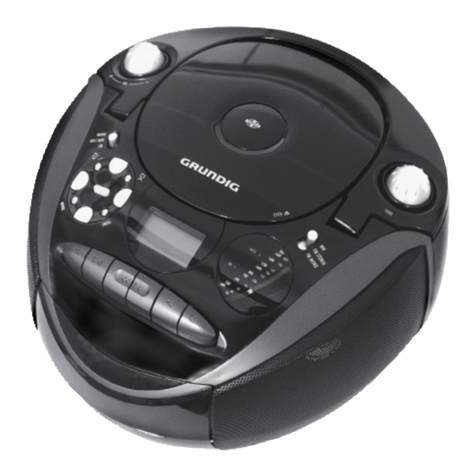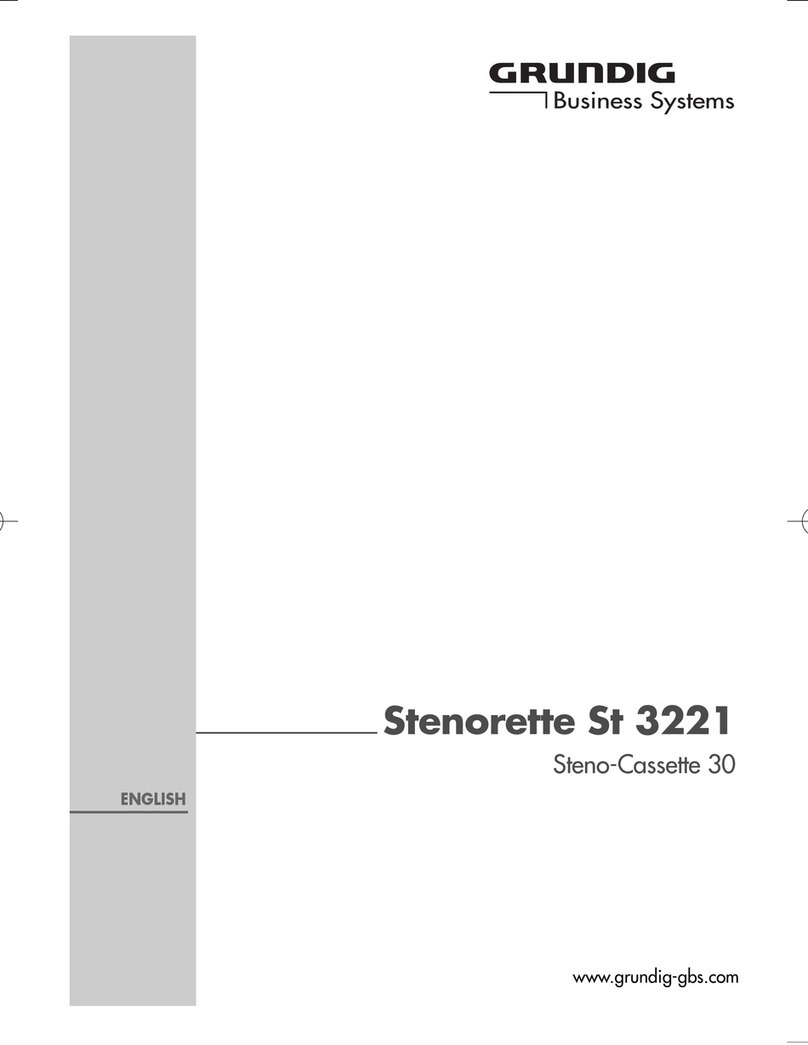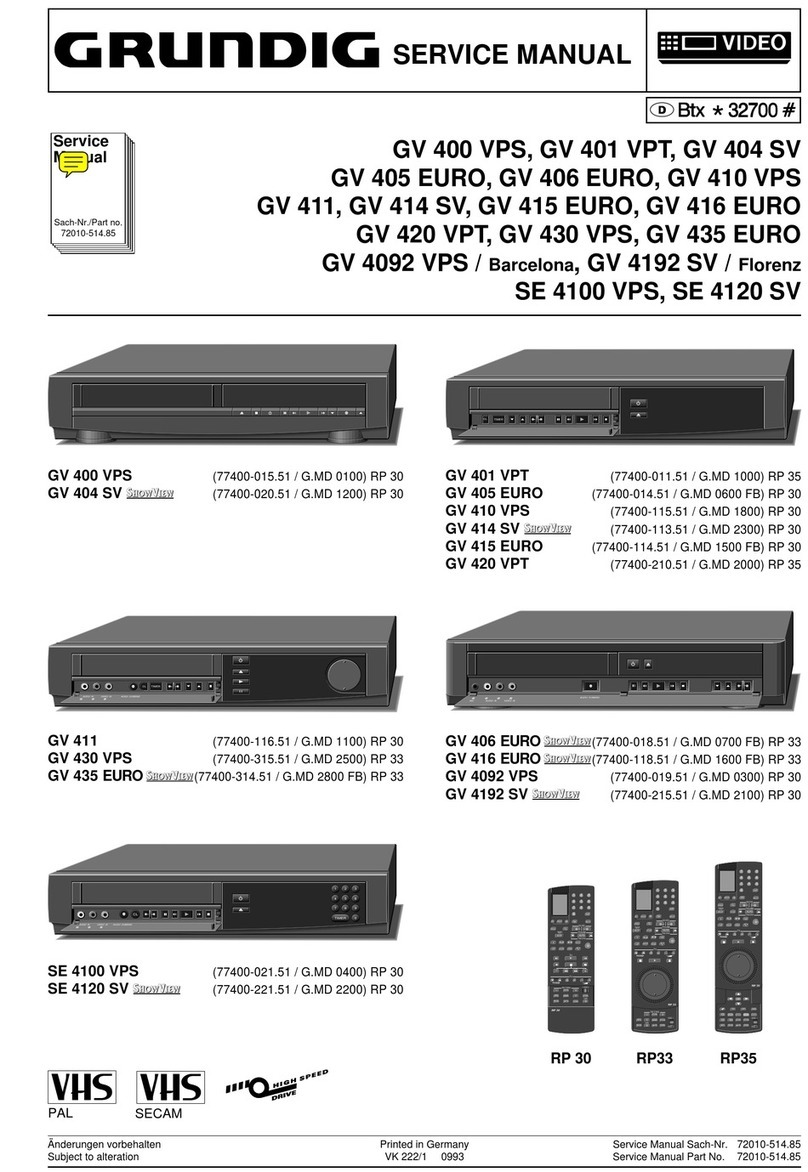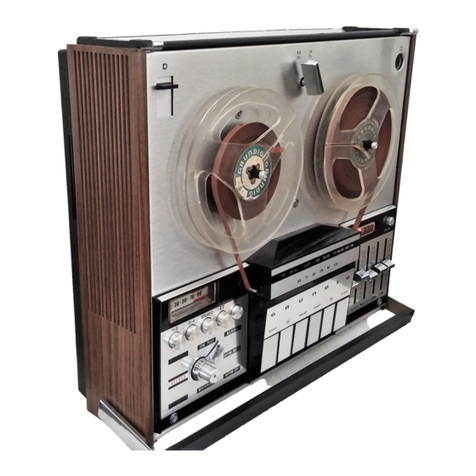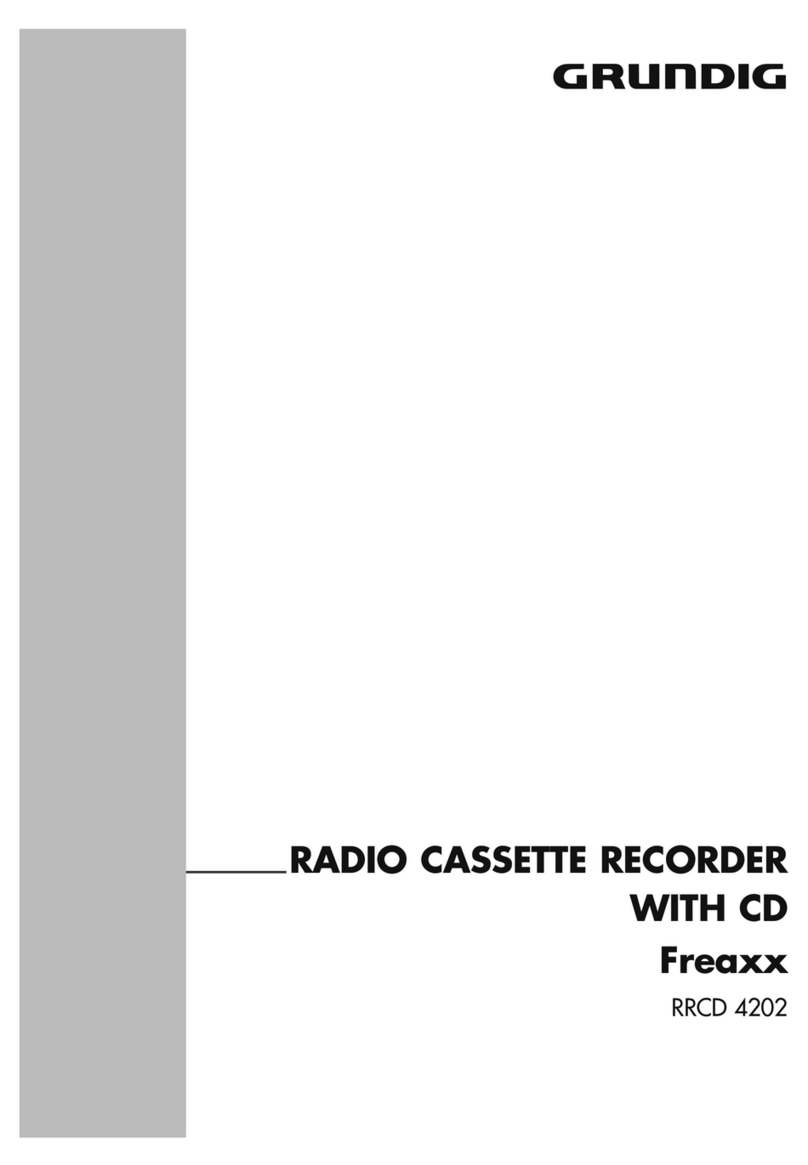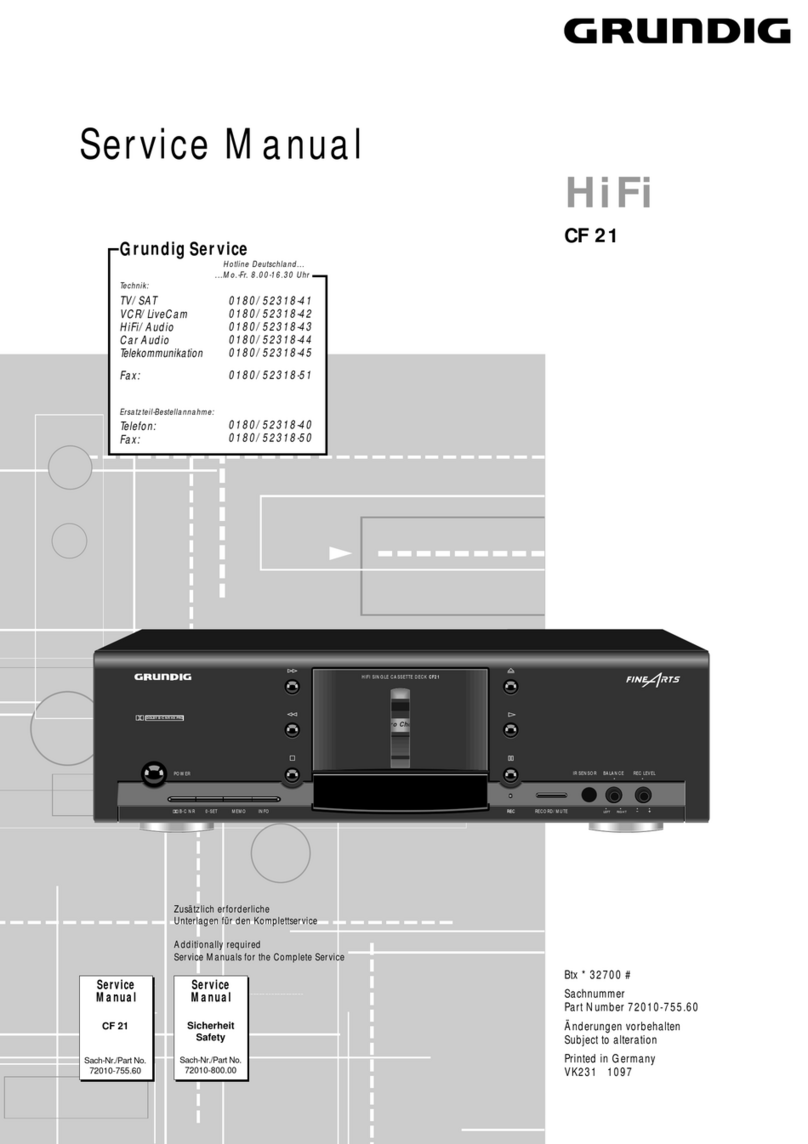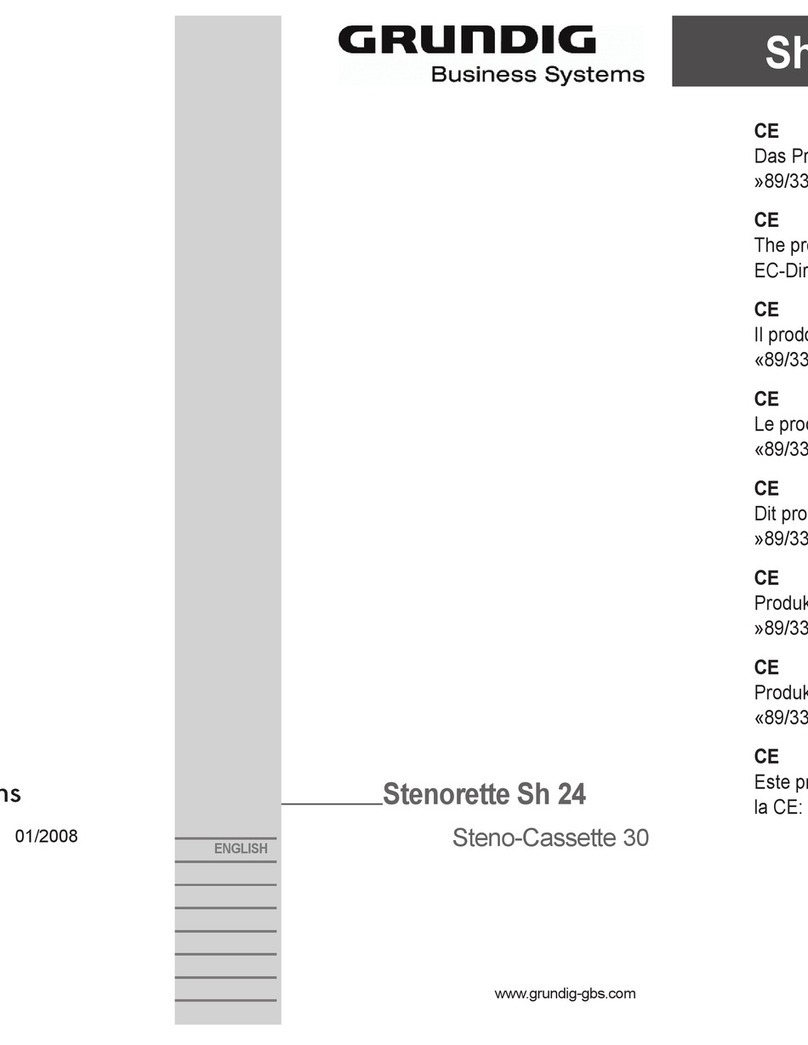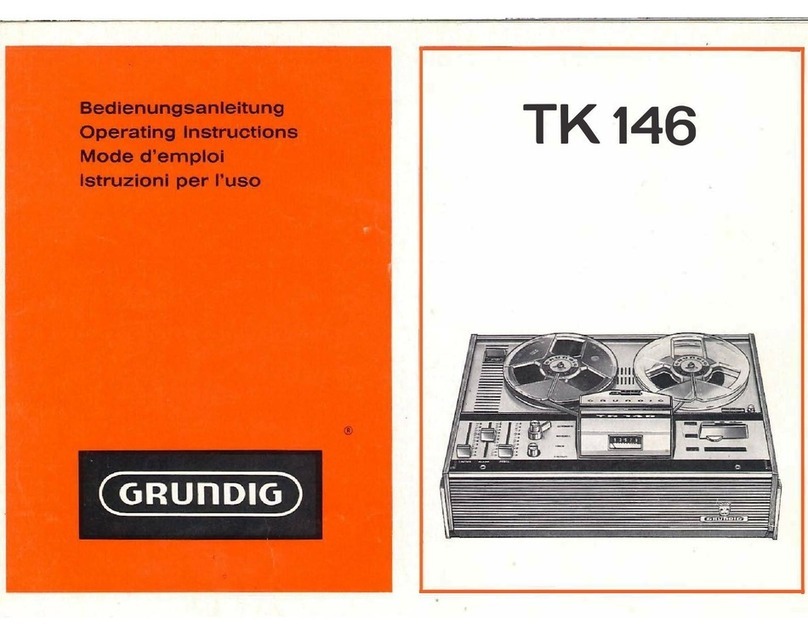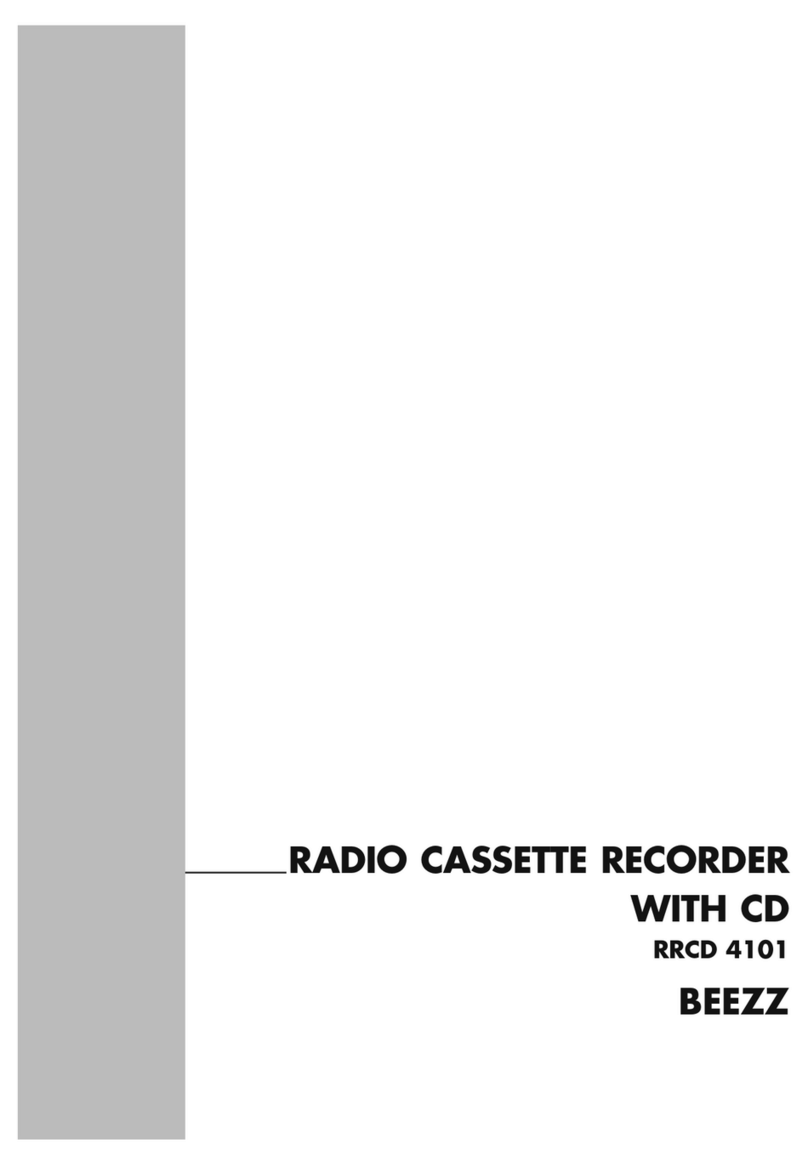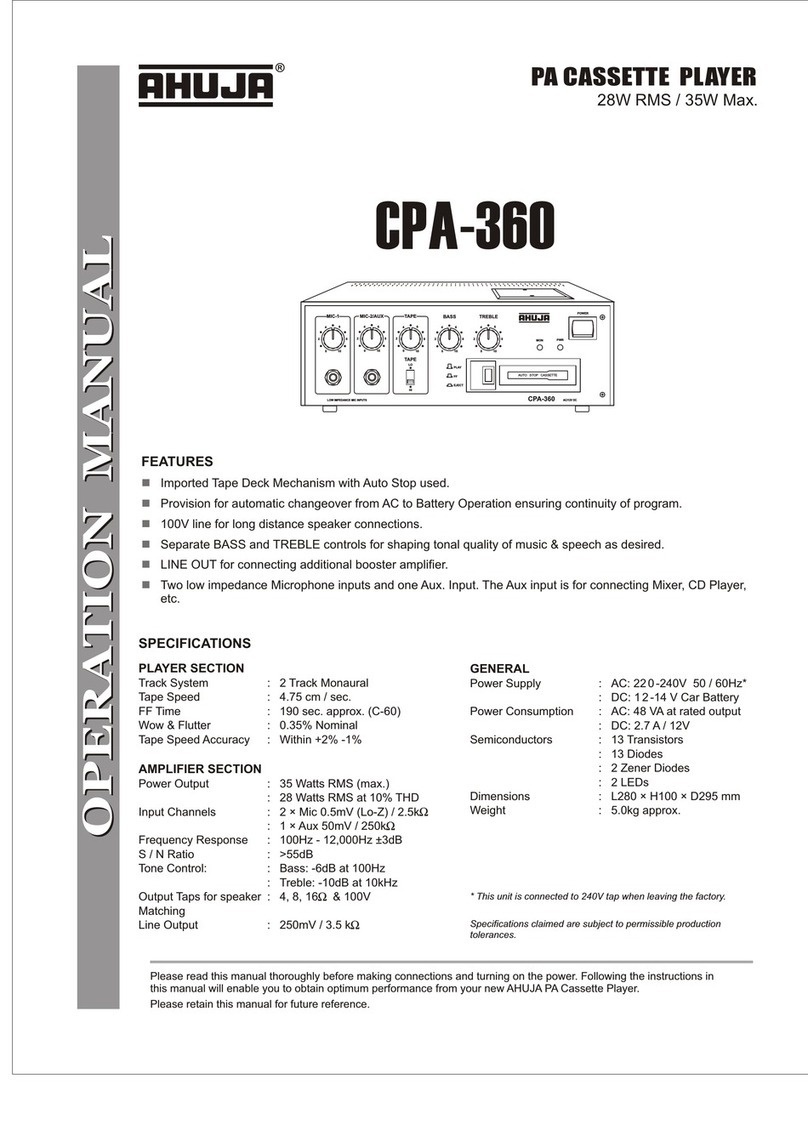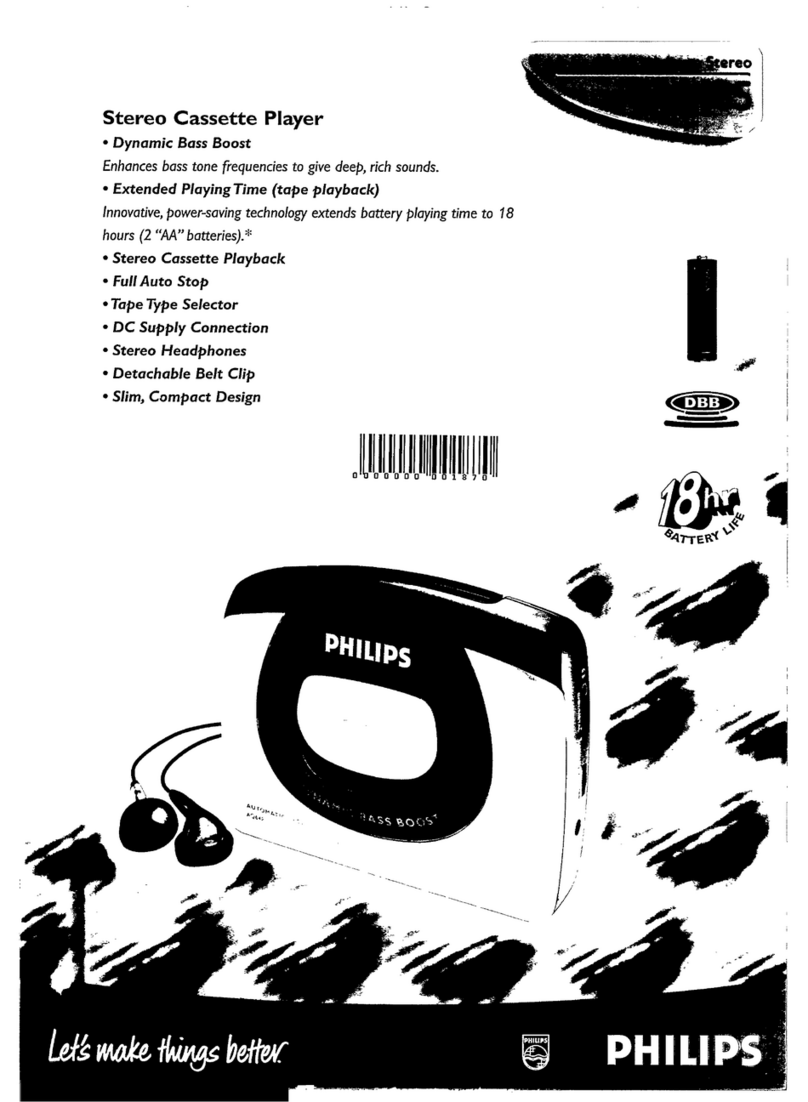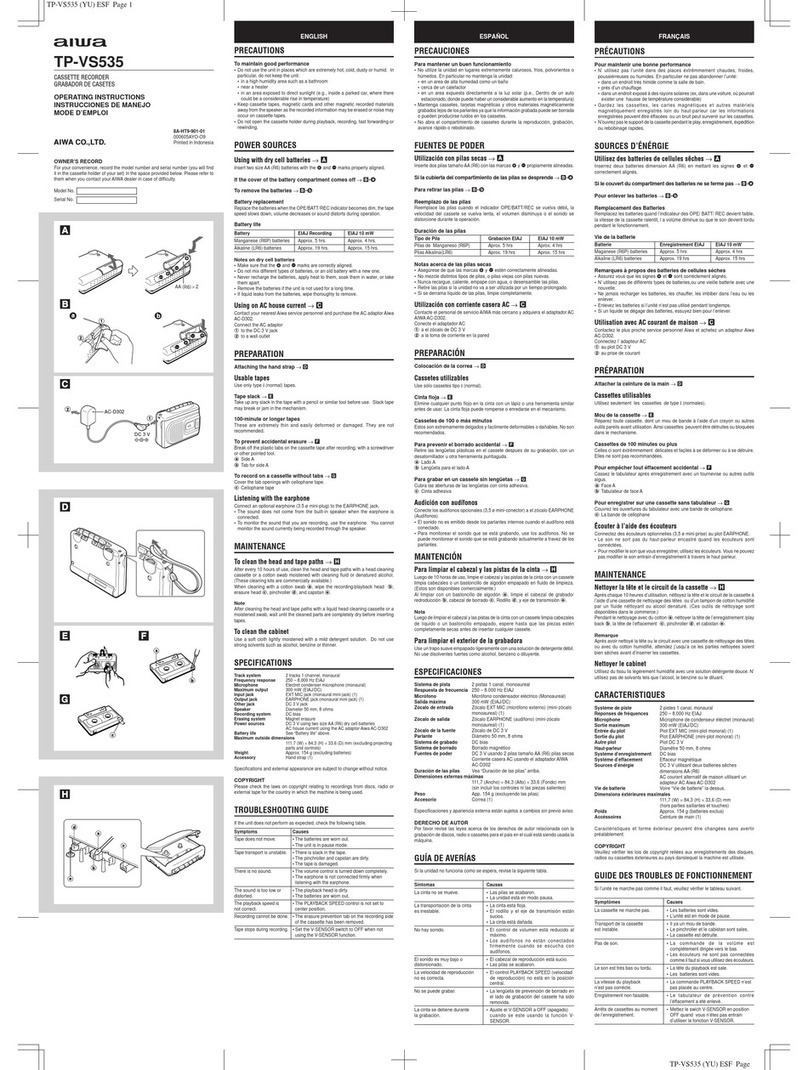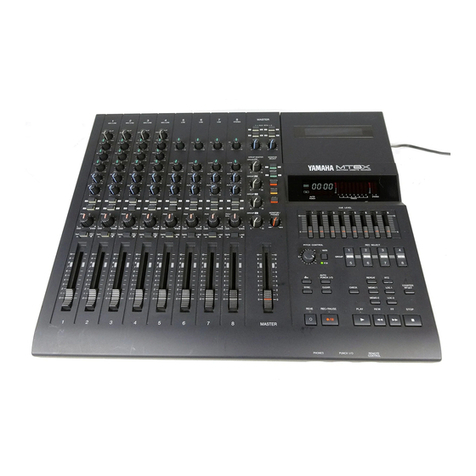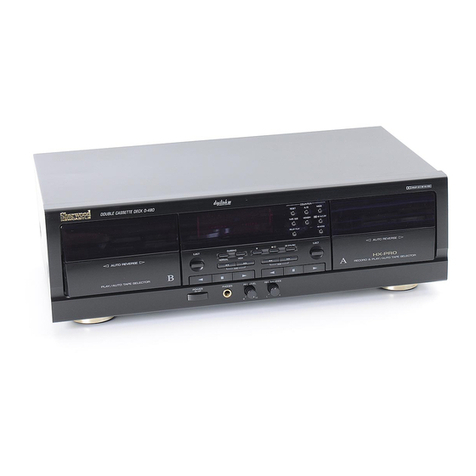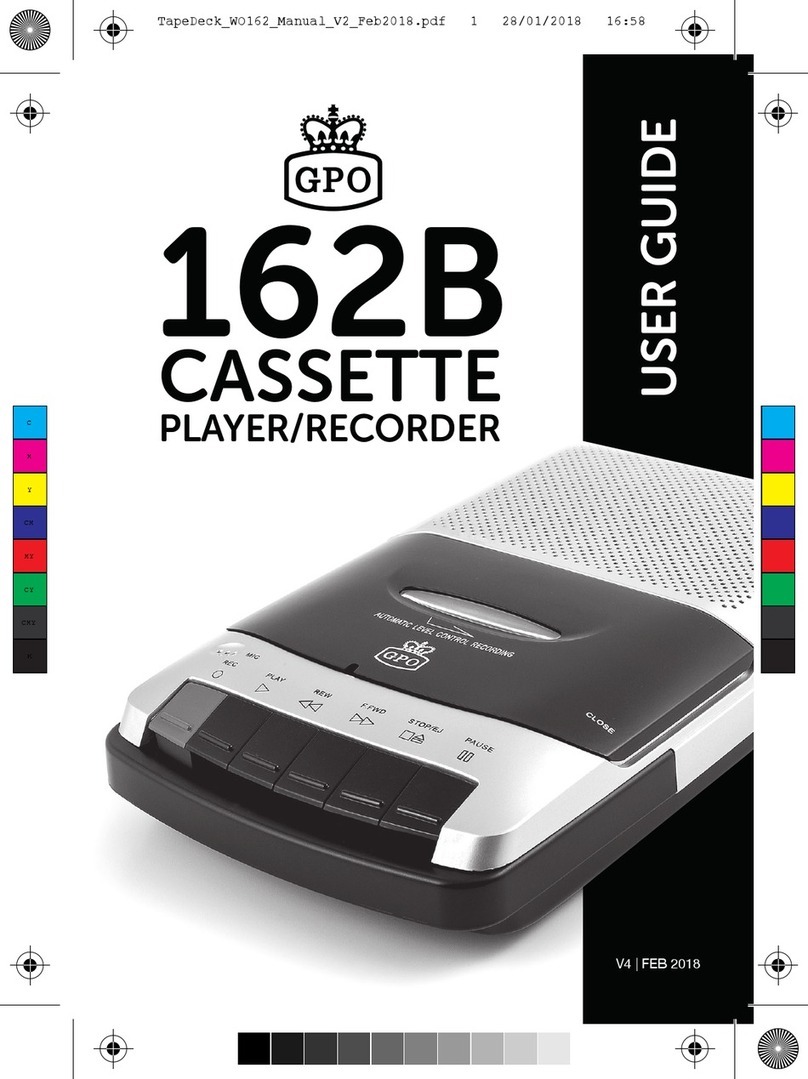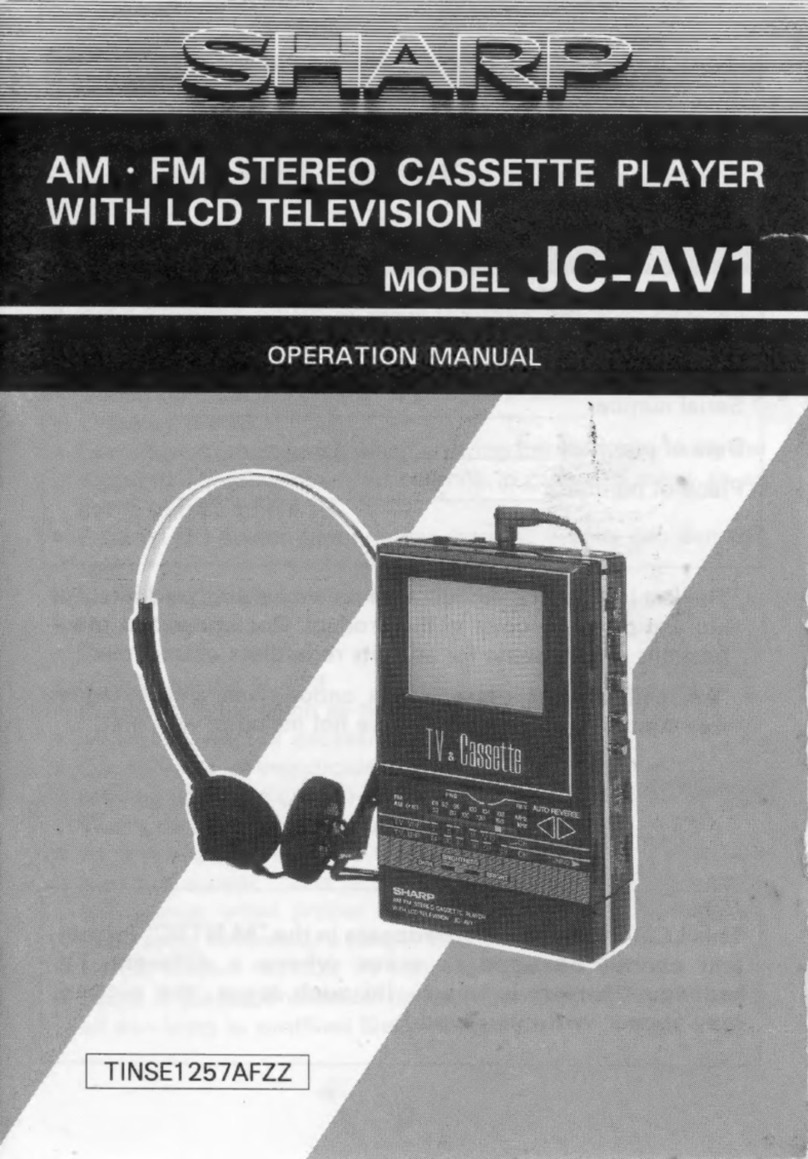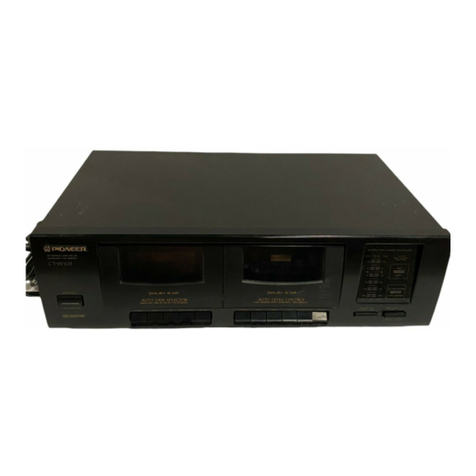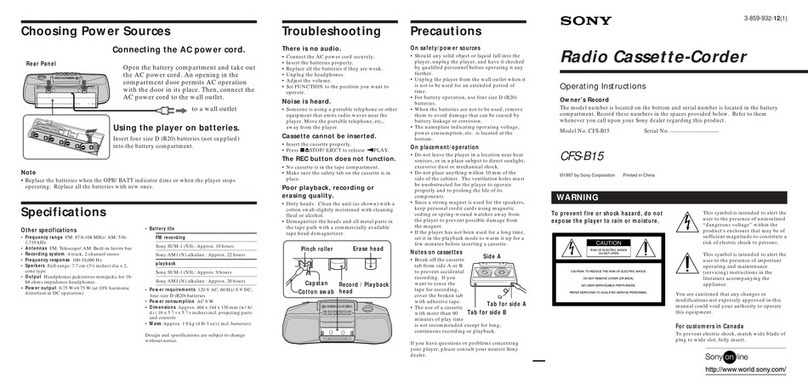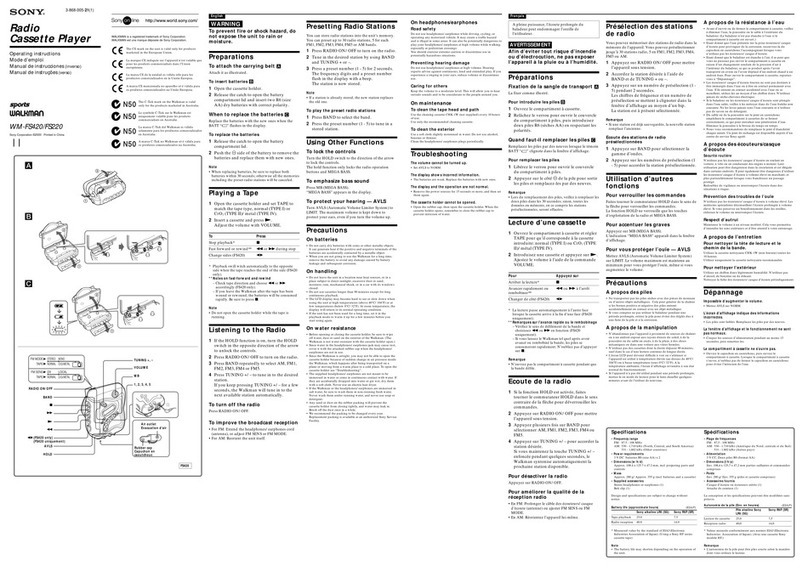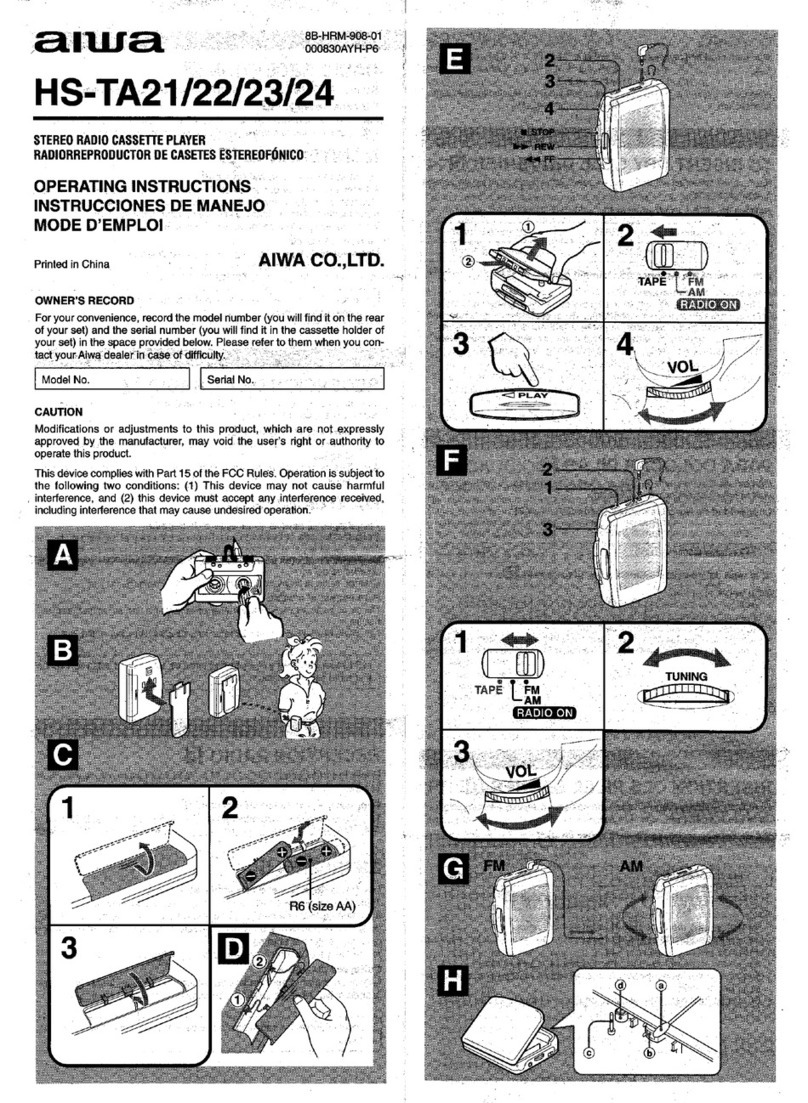
-
Laufwerk
ausbauen,
Pkt.
5
-
Take
out
the
drive
mechanism,
para
5.
-
Sicherungsring
76
(die
Positionsnummer
76
kommt
in
der
Explo-
-
Pull
the
retaining
ring
76
off
the
axis
of
the
pressure
roller
(the
sionszeichnung|
2
\der
Ersatzteilliste
mehrmals
vor)
aus
der
Ach-
position
number
76
is
found
several
times
in
the
exploded
senkerbe
der
Lagerachse-Andruckrollenhebel
ziehen
und
den
view
[2]
of
the
spare
parts
list).
Replace
the
corresponding
entsprechenden
Andruckrollenhebel
wechseln.
pressure
roller
lever.
Achten
Sie
beim
Einbau
des
Hebels
auf
die
richtige
Lage
der
An-
When
fitting
the
lever
take
care
of
the
correct
position
of
the
druckfedern
62
bzw.
63.
pressure
spring
62
or
63.
7.
Schwungrad
31
bzw.
32
wechseln,
(Abb.
5
und
Explosions-
7.
Replacement
of
flywheel
31
or
32,
(Fig.
5
and
Exploded
Pa
zeichnung|
2)
view[
2
})
wu
«8
-
Gehauserickteil
abnehmen,
Pkt.
1
-
Remove
the
back
panel,
para
1
a
5
8
e
-
Verstarkerpiatte
herausklappen,
Pkt.
2
-
Let
down
the
amplifier
PCB,
para
2
2
<
3
S
-
Laufwerk
ausbauen,
Pkt.
5
-
Take
out
the
drive
mechanism,
para
5
$
et
S
-
Profilriemen
abnehmen,
nach
Pkt.
3
verfahren.
-
Remove
drive
belt
as
described
under
para
3
om
-
Olfangring
(Siri,
Sach
Nr.
75986-436.39)
von
der
Tonwelle
(Cap-
-
Remove
the
dust
washer
(Siri,
part
no.
75986-436.39)
from
the
stan)
abziehen,
darunter
kann
sich
noch
eine
kleinere
Scheibe
capstan;
a
smaller
washer
may
be
found
below
it.
befinden.
|
-
Pull
out
the
flywheel
to
the
back.
-
Die
entsprechende
Schwungscheibe
nach
hinten
herausziehen.
Take
care
of
the
flywheel
gear
47
when
removing
and
refitting
the
Achten
Sie
beim Aus-
und
Einbau
auf
das
Zahnrad
47,
(Explo-
flywheel
(exploded
view!
2]
).
The
flywheel
gear
with
its
two
sionszeichnung
).
Das
Zahnrad
muB
mit
seinen
zwei
Zapfen
studs
must
be
fitted
into
the
provided
holes
of
the
new
flywheel.
in
die
dafr
vorgesehenen
Lécher
des
neuen
Schwungrades
After
having
fitted
the
new
flywheel
and
dust
washer
on
the
w
a
B
gesteckt
werden.
capstan,
the
capstan
must
be
cleaned
with
spirit
or
benzene.
a
<
Ist
das
neue
Schwungrad
eingebaut
und
der
Olfangring
Uber
die
=
5
Tonwelle
geschoben,
muB
die
Tonwelle
(Capstan)
mit
Spiritus
g<
oder
Testbenzin
gereinigt
werden.
a
8
<c
mW
Bel
|
oe
cio
|_|
(regres
T
WIEDERGABEKOPF
PLAYBACK
HEAD
SS
8.
Kopfwechsel,
(Abb.
4
und
8)
-
Gehadusertckteil
abnehmen,
Pkt.
1
-
Eventuell
die
Cassettenklappe
121
(mit
Equalizer)
durch
Heraus-
drehen
der
Halteschrauben
C
(Abb.
1)
weiter
dffnen.
8.
Replacement
of
the
head
(Fig..
4
and
8)
-
Remove
the
rear
of
the
cabinet,
para
1
-
In
order
to
increase
the
opening
of
the
cassette
compartment
lid
121
(mit
equalizer),
if
necessary,
undo
the
retaining
screw
C
SR
-
SILBER
SILVER
ARGENT
ARGENTO
LEITUNGSVERBINDUNGEN
-BEAT
BOY
280-
WIRING
DIAGRAM
Werden
diese
Werte
nicht
erreicht,
so
sind
die
Schwungrader
31
und
32
mit
ihren
Capstanwellen,
der
Profilriemen
3
und
die
31
and
32
and
their
capstans,
the
drive
belt
3
as
well
the
motor
pulley
and
clean
them,
if
necessary.
:
«2
gy
-
Flexprintleitung
Kopfanschllsse
von
der
Verstarkerplatte
abléten;
(Fig.
1).
beachten
Sie
Pkt.
2
a).
-
Unsolder
the
fiexprint
connected
to
the
head
contacts
from
the
6
-
Drehen
Sie
die
Kopfschraube
75b
heraus
und
ziehen
Sie
den
amplifier
board;
please
refer
to
point
2a.
wO/22a6g
=
E
38
cv
Wiedergabekopf
mit
seiner
Kopfgabel
zwischen
dem
Schrauben-
-
Undo
the
head
screw
75b
and
pull
out
the
playback
head
with
its
E
g
GOOG
g
PS
az
8
29
J
kopf
75a
und
der
Kopffeder
28
heraus.
bracket
between
the
screw
head
75a
and
the
head
spring
28.
>
5
°}
>
x
2
-
Wiedergabekopf
wechseln
-
Replace
the
playback
head.
s
$2/°
=
o
-
Kopfschraube
75b
bis
zum
Anschlag
eindrehen.
Die
Kopfschrau-
-
Screw
down
the
head
screw
75b
completely.
The
head
screw
a
w
°
way
_
be
75a
dient
zur
Kopfspalt-Senkrechtstellung
(Azimut)
und
darf
75a
is
used
for
vertical
adjustment
of
the
head
gap
(azimuth)
and
2
2
E
a
Q g
wu
Er-rE
nicht
festgedreht
werden.
Die
Kopfspalt-Senkrechtstellung
wird
must
not
be
tightened.
The
vertical
adjustment
of
the
head
gap
6
Fm
|
£355
Z
4
a2
im
elektrischen
Teil
beschrieben.
is
described
in
the
Electrical
Section.
-
=
9
PeeR
S555
I
</16
:
9.
Aufwickelmomente
9.
Take-up
torque
-
co)
;
%
5
ip
:
5
-
Drehmoment-MeBcassette
456
(Sach-Nr.
35079-014.00)
ein-
-
Load
the
torque
test
tape
cassette
456
(part
no.
35079-014.00)
4
Aaluww
&
legen
und
die
Aufwickelmomente
bei
den
Funktionen:
Wiederga-
and
measure
the
take-up
torque
in
the
following
operating
=
|
QB
222
2a.
be
normaler
Spielbetrieb
/Revers,
schneller
Vorlauf
und
Rucklauf,
modes:
normal
playback/reverse,
fast
forward
wind
and
rewind.
OO)3s%
2
225g
messen.
Normal
playback
und
reverse
30
bis
60
g-cm
200s
ined
Nommaler
Spielbetrieb
und
Reverse
..............
30
bis
60
g-cm
Fast
forward..........cccccceeeeeees
50
bis
120
g-cm
8
Fe
Schneller
Vorlauf
.............::eeeee
...
50
bis
120
g-cm
Fast
rewind.............cccsccesssesssseseeeeeeseee
50
bis
120
g-cm.
Schneller
ROcKI
auf...
esses
ceeeeetecsees
50
bis
120
g-cm.
Should
the
specified
values
not
be
achieved
check
the
flywheels
ey
5
Motor-Riemenscheibe
zu
Uberprifen
und
gegebenenfalls
zu
reinigen.
10
